16 Counts Relating to DUI Manslaughter Dropped
On September 9, 2008, St. Lucie County Circuit Judge Larry Schack entered an order suppressing a blood sample from use in the Pye case. The State subsequently dropped all 16 counts on October 1, 2008. The circumstances of this suppression are outlined in a separate article. See DUI cases. The DUI article addresses the suppression issue, but other issues which were important to the resolution of the case as well.
- The blood tests were suppressed by order of the court due to the fact that the client was misled regarding the need to give blood where there was no probable cause. The court found that the consent to give blood was coerced. Each of the troopers at the scene were asked whether they observed any evidence of impairment by drugs or alcohol. Each of the troopers responded that they did not. Indeed, no one asked the client to perform any standardized field sobriety test.
 There were problems with drug testing which was performed on the blood. Originally, the FDLE-Orlando laboratory asserted that there was methamphetamine, marijuana and trace amounts of other drugs present in the blood sample. Pre-trial discovery established that FDLE “mixed up” the blood sample for the client with another person. FDLE conceded this when it conducted an internal investigation, finding that the error occurred when marijuana test results were e-mailed to the wrong file. The trace amount of other drugs were shown to be irrelevant, because the amounts were found to be lower than the validated level of “quantitation”. Under guidelines established by the Society of Forensic Toxicologists (SOFT), the FDLE laboratory could not report a “positive” test for results which could not be quantitated – because the levels were so low, they fell below the lowest level of quantitation for which the testing method had been validated.
There were problems with drug testing which was performed on the blood. Originally, the FDLE-Orlando laboratory asserted that there was methamphetamine, marijuana and trace amounts of other drugs present in the blood sample. Pre-trial discovery established that FDLE “mixed up” the blood sample for the client with another person. FDLE conceded this when it conducted an internal investigation, finding that the error occurred when marijuana test results were e-mailed to the wrong file. The trace amount of other drugs were shown to be irrelevant, because the amounts were found to be lower than the validated level of “quantitation”. Under guidelines established by the Society of Forensic Toxicologists (SOFT), the FDLE laboratory could not report a “positive” test for results which could not be quantitated – because the levels were so low, they fell below the lowest level of quantitation for which the testing method had been validated.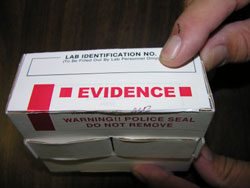 FDLE sent the blood samples to Wuesthoff Reference Laboratories in Melbourne, Florida, for additional testing. Pre-trial discovery determined that Wuesthoff used selective ion management when conducting the mass spectrometry portion of the drug testing. Requests to produce validation and calibration records, as well as depositions of personnel, confirmed that Wuesthoff destroyed calibration records more than two years old. Under SOFT guidelines, selective ion techniques are valid only when proved by contemporaneous calibration records. In this case, the calibration records had been deleted or destroyed. Even if Wuesthoff could get past the destruction of calibration records, the defense determined that Wuesthoff had diluted the blood samples which had the net effect, under SOFT guidelines, of doubling the minimum level of quantitation. The only result which might have come in from Wuesthoff was for methamphetamine – only because the results were so high that the other problems did not matter.
FDLE sent the blood samples to Wuesthoff Reference Laboratories in Melbourne, Florida, for additional testing. Pre-trial discovery determined that Wuesthoff used selective ion management when conducting the mass spectrometry portion of the drug testing. Requests to produce validation and calibration records, as well as depositions of personnel, confirmed that Wuesthoff destroyed calibration records more than two years old. Under SOFT guidelines, selective ion techniques are valid only when proved by contemporaneous calibration records. In this case, the calibration records had been deleted or destroyed. Even if Wuesthoff could get past the destruction of calibration records, the defense determined that Wuesthoff had diluted the blood samples which had the net effect, under SOFT guidelines, of doubling the minimum level of quantitation. The only result which might have come in from Wuesthoff was for methamphetamine – only because the results were so high that the other problems did not matter.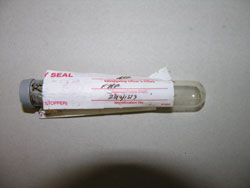
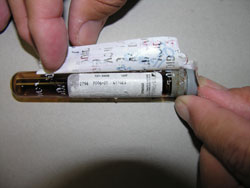
- Stephan Rose, M.D., was the defense toxicologist. He actively assisted in obtaining research showing that neither FDLE nor Wuesthoff employed adequate testing to identify exactly what type of methamphetamine was present (as well as the other testing issues already described). There are two different enantiamers of methamphetamine. One enantiamer is psychoactive (dextro-methamphetamine). The other is not. (Levo-methamphetamine). The non-psychoactive version is present, for example, in the Vicks Inhaler. When manufactured clandestinely, there is a “racemic” mixture of approximately 50-60% psychoactive. The exact proportion would depend upon the method used to manufacture the methamphetamine from other chemicals. Wuesthoff did not employ a testing protocol which could distinguish between the two different types of methamphetamine. Without a proper testing protocol, there was no way for Wuesthoff to prove how much of the methamphetamine was psychoactive. Any estimates would have been nothing but educated guesswork, which would have been excludable under SOFT guidelines. The net effect of Wuesthoff’s failure to use testing protocols which could differentiate between the two types of methamphetamine was to reduce the effective amount of psychoactive methamphetamine by half. Once this shortcoming in methamphetamine testing was recognized, it became clear that there were no studies on methamphetamine/amphetamine which would have supported a claim of impairment at the lower level.
- The State was prosecuting the client for the death of two fetuses which were, at the time of the accident, unborn. Following the accident, the mother was transported to Lawnwood Regional Medical Center and Heart Institute for evaluation. The extensive emergency room evaluation showed no risk of injury to the fetuses. The mother was, however, at extreme risk for early delivery. The defense investigation established that the mother was a heavy smoker and diabetic. She failed to take proper medication to treat her diabetes. She was obese and had experienced multiple premature births and miscarriages. Even before the accident, she was considered to be extremely high risk for pregnancy and was undergoing weekly sonograms. Against doctors’ orders, the mother rode by car to Arizona from Fort Pierce, Florida. Within 24 hours of her arrival in Arizona, she went into labor, and the two children were delivered. One died with 48 hours. One lived for almost two weeks. The State would have had extreme difficulty in causally connecting the early labor to the accident, when so many other factors were present. All available medical records showed that the pregnancy was proceeding as normally as possible for almost two months after the accident. Weekly sonograms and obstetrical examinations failed to demonstrate any evidence of fetal distress.
- After taking the depositions of the occupants of the “victim” SUV, it was determined that there were multiple problems with the accident reconstruction done by FHP. The defense employed Rick Swope as an accident reconstruction expert. The most likely point of impact was in the middle of the intersection between Okeechobee Road and Virginia Avenue.
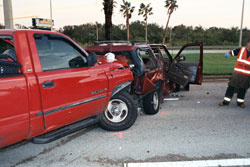
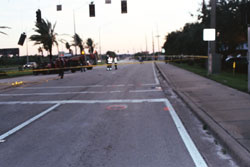
This accident occurred several hours after a hurricane had passed through Fort Pierce. The traffic signals at the intersection of a four-lane road and a six-lane road were not working. The FHP investigators maintained that the intersection was transformed into a “3-way stop”, because the signals were not working. FHP investigators maintained that all vehicles would have had to stop at the line painted in the road, which they referred to as the “stop bar”.
FHP investigators theorized that the initial point of impact was 30-40 feet before the stop bar. The defense investigation proved that the most likely point of impact was 30-40 feet past the stop bar – well beyond the point where a reasonable driver might have expected the SUV to stop.
All occupants of the SUV agreed that it had stopped just once, and that the SUV was stopped when it was hit from behind. The defense investigation maintained that the evidence proved that the SUV failed to stop at the stop bar, effectively running the imaginary stop sign (remember, the electricity to the signals was out).
The State could not show that the client’s pickup truck failed to stop at the stop bar. The driver of the SUV also asserted that there was a phantom vehicle, from a different direction, which caused her to stop. The SUV driver claimed that the phantom vehicle had, from a different direction, run an imaginary stop sign. Since the SUV stopped only once, the defense investigation concluded that it stopped because of the phantom vehicle, and that it should have stopped much sooner at the stop bar. The troopers in this case failed to collect the “black boxes” which were present in both vehicles and would have shed a great deal of light on the events immediately preceding the point of impact. Since the client was not arrested until several years after the accident, she and her defense team had no opportunity to preserve the black box either in her pickup truck or the SUV.
The defense investigation established that the client’s pickup truck was loaded with a large 4-wheeler, as well as a large tank of fuel used for heavy equipment. The defense investigation further established that the heavy, tubular steel bumper on the Pye pickup truck would tend to focus energy on a particular point. The size, weight and load of the Pye pickup greatly increased its kinetic energy at the time of impact. The energy was concentrated by the tubular bumper on the rear of the SUV. Unfortunately for the SUV occupants, the pickup’s bumper was higher than the SUV’s, which allowed the pickup to “override” the SUV bumper. The defense investigation established that the SUV had no structural components to protect the occupants. Therefore, the SUV folded like an accordion even in a low speed impact.
The defense established that the evidence was not inconsistent with the pickup stopping at the stop bar, then proceeding in a normal fashion. Since the attention of the driver of the pickup would have been focused on the far left (due to the peculiar layout of the intersection), the driver would not have seen the SUV come to a sudden and unexpected stop in the middle of the intersection. The defense position was that the accident either resulted from the SUV stopping in the wrong location (for whatever reason), or the SUV having to stop in order to avoid the phantom vehicle which had run the imaginary stop sign from a different direction.
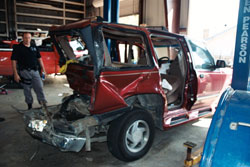 There was no evidence placing the client behind the wheel of the pickup truck. The only evidence of her driving was her presence at the scene. When law enforcement first arrived, there were also other persons present. One occupant of the victims’ SUV claimed to have seen two people in the pickup, but was unable to place the client in the driver’s seat.
There was no evidence placing the client behind the wheel of the pickup truck. The only evidence of her driving was her presence at the scene. When law enforcement first arrived, there were also other persons present. One occupant of the victims’ SUV claimed to have seen two people in the pickup, but was unable to place the client in the driver’s seat.
Another witness claimed to be a friend of an occupant of the SUV. The friend claimed to have received a telephone call while in the shower. The friend claimed that she was able to get out of the shower, get dressed, and drive several miles to the scene of the accident in order to arrive before any emergency vehicles. The defense obtained cell phone records showing the exact times. These cell phone records, when compared to 911 and FHP arrival records, showed that the “friend” did not arrive until after several emergency vehicles. At that time, the client was not, and could not, have been in the pickup. Thank goodness for cell phone records!
As can be seen, there were a variety of reasons why this prosecution was abandoned by the State.
